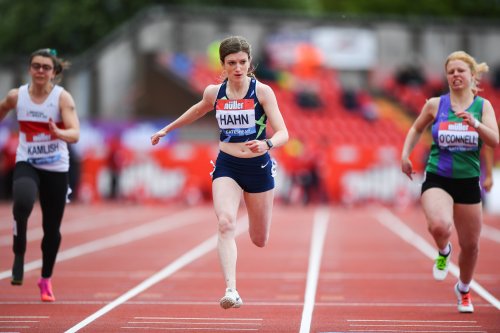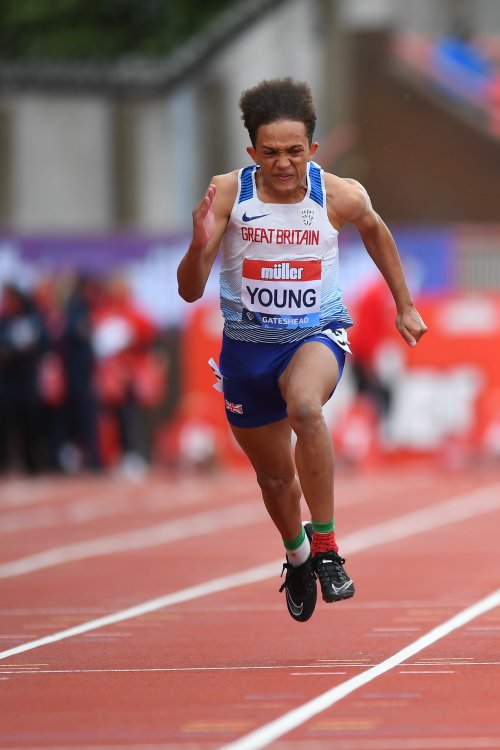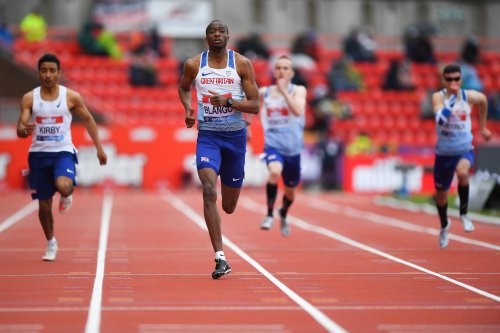This piece is on the Para races at the Doha Diamond League last week. Stuart Weir wrote this and sent some magnificent pictures.
His comments are thought-provoking. Please consider them. Para races need the respect that they deserve and also DL meetings give them street cred.
 Sophie Hahn wins 100m (T38), photo by Diamond League
Sophie Hahn wins 100m (T38), photo by Diamond League
Para races
There were also four para-athletics races. While it was brilliant to see para-athletes given the chance to be part of a Diamond League program, I fear that the concept is flawed. You know how Diamond League events work, the important disciplines like track races take place within the two hours of live TV coverage, and field events are often scheduled before that. The para-athletics events took place even before the men’s long jump and women’s shot put. We will return to why the concept is flawed but let’s start with what happened.
 Thomas Young, Gateshead Diamond League Para athletics, May 23, 2021, photo by Diamond League AG
Thomas Young, Gateshead Diamond League Para athletics, May 23, 2021, photo by Diamond League AG
Thomas Young T38 Cerebral Palsy) won the first 100-meter race in 11.71. He said afterward: “I feel really good, it was great to be back here and to take the win. The false start confused me because I thought we all started well. But I managed to keep calm and go back and start strongly to get the win”.
 Colomba Blango, T20 200m, photo by Diamond League
Colomba Blango, T20 200m, photo by Diamond League
The second men’s event, a 200m race, was won by Columba Blango (T20 Intellectual disability) in 23.19. He said of his win: “It was tough. Conditions were difficult especially on the home straight. I knew the rain was coming and the wind was really strong but I stayed focussed”.
Sophie Hahn (T38 cerebral palsy) won the women’s 100m in 13.31commenting: “I’m feeling good. The wind was so strong out there. When I was doing blocks, I thought it was going to be interesting, but I’m happy with the win. Training is going very well and I’m looking forward to the European Champs next week”.
Ali Smith (T38 cerebral palsy) won the 200m in 28.86. Smith said afterward: “That was really good fun. I always enjoy Diamond Leagues. I’m honestly a 400m runner but that was hard as it was a different speed to the 400m. It was raining and pouring but I didn’t care as it was so nice to be back!”
Now, I love Para-athletics. I have been to the past four World Championships and the last two Paralympics. I know some of the athletics running at Gateshead. I have nothing but respect for them. They work as hard as so-called “able-bodied” athletes.
The problem with the races is that the concept of combining classifications to put an athlete with severe CP, an athlete with mild CP, an amputee, and a blind athlete in the same race is simply flawed. Take the women’s 100m, which Sophie Hahn won in 13.31. I have lost count of the number of times I have seen Sophie break her own world record. She is an amazing athlete. The problem is that Maria Lyle who finished last in that race in 14.84, meters behind Hahn is also a superb athlete who has won medals at World, Paralympics, Commonwealth Games, etc. The reason that she finished the last 1.53 seconds behind Hahn is not that she is a poor athlete but because it was an unfair race. Another example, the men’s 100m had athletes from 6 different classifications in one race. It was equally distressing to see Richard Whitehead who has won 5 World Championship and two Paralympic gold medals, finish last, 2.5 seconds behind the winner.
I understand that there is no budget to bring international para-athletes from the correct classifications to make fair races. I understand too that this concept allowed 25 British para-athletes to be part of a Diamond League program. But does it do the athletes a service or disservice? The results and start-lists on the Diamond League website include no information on classification, leaving one to assume that all athletes are equal and some a lot better than others
It would help greatly if the stadium announcers and the TV commentators explained what was going on and the race was not the usual first past the post wins – but that “winning” was a lot more complicated. There is a points system that can be used to establish a level playing field between different classifications. But even that is unsatisfactory as I recall watching Stef Reid jumping furthest in the T44 long jump at the London Paralympics but finishing second on points.
One solution would be to return to the handicap races of old with athletes with a more severe disability starting ahead of those with lesser disability. That would make for a closer race with – if the handicap was correct – all athletes arriving at the finish at about the same time. That would be a great spectacle but would, of course, deprive most of the athletes of a 100m time.
I spoke to Kirsty Taylor a T44 (leg amputee) athlete who was in the 100 race. She acknowledged the problem: “It’s always a difficult one. I understand that there can’t be an individual race for each class. You want to showcase your best athletes but often that will have to be across different classifications. I was grateful to be invited and you go into the race knowing it’s a mixed classification race. But it is hard going into a race knowing it’s not a race that you are ever going to win”. She also pointed out that it is quite common for para-athletes to find themselves in mixed-classification races.
She dismissed using the points system and was unsure about how a handicap race would work: “[A handicap race] would certainly be an unusual one. The start line would look a bit strange. But potentially yes. There is a points system to determine places in the mixed classification race – but that doesn’t really work for television and nobody cares about the points afterward – it’s about who crosses the line first. Ideally, you would want a strong field of athletes in the same classification competing against each other”. Again, she stressed the importance of communicating to spectators and the TV audience: “The commentator needs to say something like ‘this is a mixed classification race with athletes competing for times not really against each other.'”
The solution, she suggested, was for an athlete to have a clear goal for the race: “Your mindset has to shift because you are in a race with athletes with whom you are not really comparable. You’re not competing against the others; you are competing for yourself and for a time and competing to enjoy being part of a Diamond League. It can be frustrating, especially if you’re a lower classification. It lacks the close competition that you get in a race of athletes with similar speeds and times. You have to change your objectives and decide what your focus is going to be – is it executing a certain part of your race? It is the time?”
I commend the organizers for including para events but I did feel for someone like Maria Lyle coming in last with people, perhaps, assuming that she wasn’t very good, while in reality, she is a brilliant athlete.
Author

Since 2015, Stuart Weir has written for RunBlogRun. He attends about 20 events a year including all most global championships and Diamond Leagues. He enjoys finding the quirky and obscure story.
View all posts




















